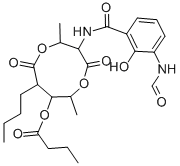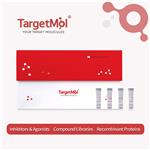Description
Antimycin A
4 is an active component of the antimycin A antibiotic complex that is more polar than antimycin A
1 , antimycin A
2 , and antimycin A
3 . Antimycin A
4 inhibits ATP-citrate lyase with a K
i value of 64.8 μM. The antimycin A complex is a mixture of antimycins A
1, A
2, A
3, and A
4 that demonstrates antifungal, insecticidal, nematocidal, and piscicidal properties. It blocks mitochondrial respiration and can deplete cellular levels of ATP
via inhibition of complex III of the mitochondrial electron transport chain (ETC). Antimycin A prevents the transfer of electrons between the b-cytochromes and ubiquinone at the Q(inner) site of complex III. This results in the stabilization of the ubisemiquinone radical at the Q(outer) site of complex III, leading to increased production of superoxide. Antimycin A is widely used in research to shunt electron flow through the ETC to study the chemical details of oxygen respiration. Additionally, antimycin A has been shown to inhibit Bcl-2 and Bcl-xL proteins, inducing apoptosis.
Chemical Properties
Antimycin (A3C26H36N2O9) and (Antimycin
A1) C28H40N2O9 are crystalline solids.
Uses
Antimycin A4 is the most polar of the major components of the antimycin complex, first isolated in 1958 from Streptomyces blastimyceticus and co-produced with antimycin A3. Like all antimycins, antimycin A4 is a potent inhibitor of respiration by inhibiting the oxidation of ubiquinol to ubiquinone. Antimycin A4 exhibits broad biological activity as an antifungal, anthelmintic, insecticidal, antiviral and antitumor active. Lack of availability of the individual antimycin components has hindered greater understanding of the common and unique molecular targets of the components of the antimycin complex.
Safety Profile
Poison by subcutaneous,intravenous, and intraperitoneal routes. When heated todecomposition it emits toxic fumes of NOx.
Potential Exposure
Specific uses for antimycin A were
not found, however, antimycin A1, and antimycin A3 are
reported to be antibiotic substances produced by streptomyces
for use as a fungicide, possible insecticide and miticide.
Registered as a pesticide in the U.S.


